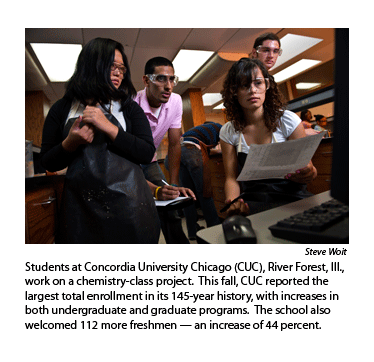By Paula Schlueter Ross
For the eighth consecutive year, total enrollment at the Synod’s 10 Concordia University System schools has hit a record high. This fall, a total of 25,516 graduate and undergraduate stud ents — an increase of 2,198 students, or 9.4 percent — are enrolled at CUS schools nationwide, according to preliminary figures compiled by the Synod’s Board for University Education (BUE).
ents — an increase of 2,198 students, or 9.4 percent — are enrolled at CUS schools nationwide, according to preliminary figures compiled by the Synod’s Board for University Education (BUE).
Like previous years, the jump is due primarily to an increase in the number of graduate students — from 10,180 last fall to 11,664 this year, an increase of 1,484, or 14.5 percent.
But the number of undergraduates also grew in the past year — from 13,138 to 13,852, an increase of 714 students, or 5.4 percent.
“We’re very pleased,” said Dr. Kurt Krueger, executive director of the BUE and president of the Concordia University System (CUS). Over the past five years, total CUS enrollment has increased 37 percent, Krueger noted.
“I really believe that our enrollments are up because we continue to offer high-quality academic programs,” he said. Student support systems at the schools also are a factor, he added: “Once students get into a Concordia, they generally like it very much and will persist to graduation.”
That student support — particularly during the entire recruitment process — is a priority at Concordia University Chicago (CUC), in River Forest, Ill., which reported this fall the largest total enrollment in the school’s 145-year history, with increases in both undergraduate (1,269 — up 116 students, or 10 percent) and graduate (3,780 — up 748 students, or 25 percent) programs.
Also this fall, the school welcomed 112 more freshmen than last year — an increase of 44 percent, which represents “the most significant growth at the undergraduate level in a single year,” according to Evelyn P. Burdick, vice president for enrollment and marketing at CUC.
At the undergraduate level, Burdick credits the school’s “enrollment best practices that blend and integrate technology, key data assessment, and personal communication,” enabling counselors to easily monitor students’ progress through the admissions process, and communicate “quickly and easily” with them, thus “building important relationships” with students right away.
One student wrote on a CUC survey that the school’s admissions staff “made every effort to make me feel comfortable and get to know me personally. They gave me honest advice and support. I did not find this with other colleges.”
The school’s graduate cohorts have grown every year since 2003, Burdick said, and “continue to be immensely popular with area educators.” CUC offers graduate courses both on campus and at more than 70 off-site locations, typically in area high schools, and regularly adds courses that are “in demand” by students. Formats include both face-to-face classroom instruction and online learning.
“We are intentionally developing academic programs of interest to students in the markets we serve, and programs that advance our mission,” she said.
In addition to CUC, with 3,780 students, the CUS schools with the largest graduate enrollments are Concordia University Wisconsin, Mequon, with 3,091; Concordia University, Irvine, Calif., with 1,133; Concordia University Texas, Austin, with 1,076; and Concordia University, St. Paul, Minn., with 1,026.
Those with the largest undergraduate enrollments are Concordia, Mequon, with 4,087; Concordia, St. Paul, with 1,790; Concordia, Irvine, with 1,431; CUC, with 1,269; and Concordia University Nebraska, Seward, with 1,257.
According to Krueger, CUS schools with nursing programs (in Irvine, Calif.; Mequon, Wis.; Bronxville, N.Y.; and Portland, Ore.) “continue to attract more applicants than they can accept.” And two schools — in Mequon and in Portland — are in the process of opening a pharmacy program and a law school, respectively, which “will attract even more students,” he said.
But, alongside the growth in this fall’s enrollment, the number of students studying for church careers continues to decline, for the eighth straight year.
This fall there are 1,900 students in CUS church-work programs, a drop of 134 over last year. But the “good news,” notes Krueger, is that the trend seems to be slowing — in each of the past four years, the drop in church-work students was higher: some 200 or more.
While he’s happy about the apparent slowdown, he says he’s “still very concerned” about the loss of students.
“I think we still need to work through initiatives like ‘What a Way’ to keep attracting our young folks into church work,” Krueger told Reporter. “Most of our schools do a very good job of trying to identify and recruit high-quality young people to go into professional work in the church. So we need to keep working at it and hope the decline has been arrested.”
“What a Way,” provides resources for those interested in pursuing church careers and for those who already are serving the church. Among those resources are descriptions of various church careers, contact information for LCMS colleges and seminaries, FAQs, brochures, and a DVD that appeals to youth to think about their vocational choices and features professional church workers talking about their vocations.
This year’s church-work students include 1,192 teachers (down 18), 278 directors of Christian education (down 37), 245 pre-seminary (down 36), 78 lay ministers (down 43), 44 directors of family life ministry (up 2), 26 deaconesses (no change), 19 directors of parish music (down 3), and 18 directors of Christian outreach (up 1).
Church-work students typically receive close to half their tuition in scholarship aid, according to Krueger. Tuition and fees at CUS schools range from a low of $7,250 at Concordia College, Selma, Ala., to a high of $26,400 at Concordia, St. Paul, with the average around $21,000 per year — some $3,000 less than the national average for four-year private institutions, he said.
And, while the number of LCMS students dropped by 272 (from 4,586 last year to 4,314 this year), the number of “other Lutherans” grew by 370 students, or 24 percent, to 1,921.
This fall’s enrollments — including both graduate and undergraduate students — at individual CUS schools are as follows:
- Concordia University, Ann Arbor, Mich. — 747 (a decrease of 105 students, or 12 percent, over fall 2008).
- Concordia University Texas, Austin — 2,244 (down 25, or 1 percent).
- Concordia College, Bronxville, N.Y. — 704 (down 30, or 4 percent).
- Concordia University, Irvine, Calif. — 2,564 (up 111, or 4.5 percent).
- Concordia University Wisconsin, Mequon — 7,178 (up 629, or 10 percent).
- Concordia University, Portland, Ore. — 1,901 (up 192, or 11 percent).
- Concordia University Chicago, River Forest, Ill. — 5,049 (up 864, or 21 percent).
- Concordia College, Selma, Ala. — 596 (up 17, or 3 percent).
- Concordia University, St. Paul, Minn. — 2,816 (up 172, or 6.5 percent).
- Concordia University Nebraska, Seward — 1,717 (up 373, or 28 percent).
Seminary enrollment
Total enrollment in all programs at the Synod’s two seminaries combined is down — from 1,085 last year to 1,028 this year, a drop of 57 students, or 5 percent.
The total number of residential students enrolled in programs leading to ordination at both seminaries also has fallen — from 660 to 622, a drop of 38 students, or 6 percent.
Total non-residential students in programs leading to ordination at both schools is up by one — from 212 to 213. Last year saw a larger gain in the non-residential category (up 77 students) because 55 students began studies in the Specific Ministry Pastor (SMP) program. This year, there are 35 new SMP students.
“SMP was a new program last year, and there was anticipation for it … and so there was an initial surge through the gates when it opened,” explained Dr. Glen Thomas, executive director of the Synod’s Board for Pastoral Education.
Total ordination-track enrollment at both seminaries fell this year by 37 — from 872 to 835.
While residential formation of pastors is “extremely important” — even today’s distance-education programs are including on-campus components — “we are still, I think, in the process of looking at what role and what proportion is distance education going to play,” Thomas said. This fall, about a fourth of incoming ordination-track students at both seminaries combined are in distance-education programs.
The BPE and the LCMS President’s Office are sponsoring a pastoral ministry summit Nov. 4-5 in Fort Wayne, Ind., to “facilitate a vision for the future of theological education in our church,” according to Thomas, and discussion of residential and distance-education programs will be on the agenda, he said.
In addition to the slide in the number of ordination-track students at the seminaries each year, Thomas said he is concerned about the continuing drop in the number of pre-seminary students at Concordia University System schools. That figure has fallen consistently for the past five years — from 426 pre-sem students in 2005, to 245 this fall, a drop of 181 students, or 42 percent.
Those schools are “feeders” for the seminaries, he said, and when their numbers fall, those of the seminaries do, too.
“I would encourage pastors and other leaders in congregations to always be vigilant in identifying, informing, and encouraging future pastors,” Thomas said. “Many pastors will tell you that a big influence in their becoming a pastor was a pastor — whether it was the pastor who confirmed them, or maybe their pastor at the time they enrolled in seminary.
“And it is extremely important for the future of our church that we continue that process.”
Enrollment statistics for the seminaries individually are as follows:
- Concordia Seminary, St. Louis, reported a total enrollment of 649 students (54 fewer than last year), with 546 enrolled in programs leading to ordination, a drop of 38 students.
Its student body includes 364 M.Div. students, 12 alternate-route pastoral students, 170 non-residential pastoral students, and 16 deaconess students.
Gains were recorded in the seminary’s SMP program (the total rose from 29 to 49, with 25 new students), Cross-Cultural Ministry program (up 1), and Deaf Institute of Theology (up 1).
- Concordia Theological Seminary, Fort Wayne, reported a total enrollment of 379 (3 fewer than last year), with 289 enrolled in programs leading to ordination, a gain of 1 student over last year.
But the seminary welcomed 62 new residential ordination-track students this fall, an increase of 7 over last year.
Other gains were reported in the number of SMP students (up 6, for a total of 32) and the number of deaconess students (up 3, for a total of 34).
Its student body also includes 232 M.Div. students and 14 alternate-route pastoral students.
Tuition and fees at each of the seminaries runs about $21,600 per year.
Posted Nov. 4, 2009




